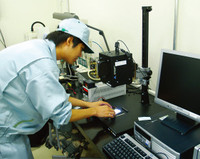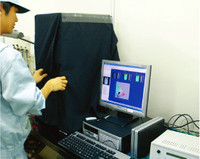Fuji Polymer Industries Co., Ltd.
Development of Functional Silicone Rubber that Transfers Heat and Electricity
Transparent and highly stable silicone rubbers— while they are widely used as sealing and cushioning materials, there are only a few companies capable of manufacturing functional silicone that conducts heat, electricity, or light.
Fuji Polymer Industries Co., Ltd. (Fujipoly) is one of these manufacturers. This well-established company was founded in 1978 through transfer of control of the Industrial Silicone Rubber Division of Dow Corning Co., Ltd., a worldwide chemical manufacturer via a joint investment with Chugai Co., Ltd.
What is unique about Fujipoly is that they have added the ability to conduct heat or electricity to their silicone parts. The products have been commercialized as the thermally-conductive and flame-retardant silicone rubber, "Sarcon Series", and the anisotropically conductive silicone rubber sheet, "Connector Series".
A New Challenge-Silicone that Transfers Light
After developing new thermally-conductive and electrically-conductive products one after another, Fujipoly launched a new challenge: the developmentof silicone rubber that conducts light. While taking advantage of the properties of transparent silicone rubber, Fujipoly made round-the-clock efforts to achieve further higher transmissivity and a uniform light-emitting face. Finally, Fujipoly succeeded in creating light guide film (LGF) using silicone rubber.
By applying special treatment to 0.2-mm thick silicone rubber film, Fujipoly realized a surface light source with high transmissivity and uniform light emission.
Measurement using CA-2000


Benefits of Introduction
1. Quantification of brightness
Grasping the current light-emitting conditions is the first step in enhancing the uniformity of light-emitting surface. Fujipoly started by checking the brightness with the human eye. They recorded the data of dark/bright parts based on the visual perception.
However, having failed to obtain stable results with the human eye, Fujipoly introduced a spot-type luminance meter.
2. Reduced measurement time
The next challenge that lay beyond was the large number of measurement points. It is necessary to capture the more detailed distribution of luminescence to realize a higher uniformity. There were cases that required measurement at more than 100 points within a sample. Given that measuring and recording the results of 1 point take 10 seconds, it would require 1,000 seconds per sample. For multiple samples, the total work time would be enormous. Around this time, Fujipoly learned about 2D Color Analyzer CA-2000, which is capable of measuring light distribution simultaneously, and tried the instrument immediately. The CA-2000, capable of measuring 980 × 980 points per measurement, contributed to a dramatic efficiency improvement.
3. Comprehensive GUI
In addition, a graphic display of the measurement results shows the effectiveness of the LGF at a glance.
Through interviewing the staff members of Fujipoly for this report, we felt that they constantly look toward new possibilities while keeping tradition going. In addition to offering support for the CA-2000, Konica Minolta will continue to be of service in the development of new products in the future.

Fuji Polymer Industries Co., Ltd.
(Toyota, Aichi, Japan)


